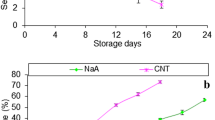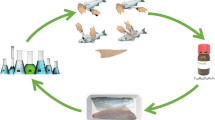Abstract
The efficacy of electrolyzed water (EW) against surface bacteria for increased freshness of fish during distribution was investigated and its efficiency was compared with chlorinated water (CW) and some natural herbal extracts. Fresh oil sardine (Sardinella longiceps), Pacific mackerel (Scomber japonicas) and horse mackerel (Trachurus trachurus) were dipped into variable concentrations of EW, CW, EW-mix (EW + bamboo extract + garlic extract at 60:1:1), sterile distilled water, tap water, garlic extract and bamboo extract for 0, 1, 3, 5, 10, 15, 20, 25 and 30 min, respectively. Aerobic plate count (APC) was done, biochemical properties were studied and freshness of fish was measured using quality assessment tool. Iso-chlorine EW, CW and EW-mix were found to be effective in reducing APC at 25 °C. Fish treated with EW and CW showed better keeping quality in terms of bacterial load and physical properties of fish compared to other solutions. So, EW can be effectively used to reduce bacterial spoilage and extend shelf life of fish during distribution and marketing.
Similar content being viewed by others
References
AMC (Analytical Methods Committee) (1990) Official methods of analysis of the association of official analytical chemists, 15th edn. Arlington, Virginia
Ankri S, Mirelman D (1999) Antimicrobial property of allicin from garlic. Microbes Infect 2:125–129
Bari ML, Sabina Y, Isobe S, Umemura T, Isshiki K (2003) Effectiveness of electrolyzed acidic water in killing Escherichia coli O157:H7, Salmonella enteritidis, and Listeria monocytogenes on the surface of tomatoes. J Food Prot 66:542–548
Cheke RA, Ward AR (1998) A model for evaluating interventions designed to reduce post-harvest fish losses. Fish Res 35:219–227
Connell JJ (1990) Control of fish quality, 3rd edn. Fishing News Books, Oxford
Fabrizio KA, Cutter CN (2003) Stability of electrolyzed oxidizing water and its efficacy against cell suspensions of Salmonella typhimurium and Listeria monocytogenes. J Food Prot 66:1379–1384
Fabrizio KA, Sharma RR, Demirci A, Cutter CN (2002) Comparison of electrolyzed oxidizing water with various antimicrobial interventions to reduce Salmonella species on poultry. Poult Sci 81:1598–1605
Feldhusen F (2000) The role of seafood in bacterial foodborne disease. Microbes Infect 2:1651–1660
Food and Agriculture Organization of the United Nations [FAO] (2000) The state of food insecurity in the world. https://www.fao.org. ISBN. 92-5-1044479. Accessed 20 Aug 2015
Goksoy EO, James C, Corry JEL (2000) The effect of short-time micro-wave exposures on inoculated pathogens on chicken and the shelf-life of uninoculated chicken meat. J Food Eng 45:153–160
Gram L, Dalgaard P (2002) Fish spoilage bacteria- problems and solutions. Curr Opin Biotechnol 13:262–266
Gram L, Huss HH (1996) Microbiological spoilage of fish and fish products. Int J Food Microbiol 33:121–137
Guentzel JL, Lam KL, Callan MA, Emmons SA, Dunham VL (2008) Reduction of bacteria on spinach, lettuce, and surfaces in food service areas using neutral electrolyzed oxidizing water. Food Microbiol 25:36–41
Howgate PA, Johnston K, Whittle J (1992) Multilingual guide to EC freshness grades for fishery products. Torry Research Station, Food Safety Directorate, Ministry of Agriculture, Fisheries and Food, Aberdeen
Huang YR, Hsieh HS, Lin SY, Lin SJ, Hung YC, Hwang DF (2006a) Application of electrolyzed oxidizing water on the reduction of bacterial contamination for seafood. Food Control 17:987–993
Huang Y-R, Shiau CY, Hung YC, Hwang DF (2006b) Change of hygienic quality and freshness in tuna treated with electrolyzed water and carbon monoxide gas during refrigerated and frozen storage. J Food Sci 71:127–133
Huang Y-R, Hung Y-C, Hsu S-Y, Huang Y-W, Hwang D-F (2008) Application of electrolyzed water in food industry. Food Control 19:329–345
Huss HH (1995) Quality and quality changes in fresh fish. FAO Fisheries Technical Paper No: 348, Rome
Izumi H (1999) Electrolyzed water as a disinfectant for fresh-cut vegetables. J Food Sci 64:536–539
Kantor LS, Lipton K, Manchester A, Oliveira V (1997) Estimating and addressing America’s food losses. Food Rev 20:3–11
Katta SR, Rao DR, Dunki R, Chawan CB (1991) Effect of gamma-irradiation of whole chicken carcasses on bacterial load of fatty acids. J Food Sci 56:371–373
Kim C, Hung YC, Brachett RE (2000a) Efficacy of electrolyzed oxidizing (EO) and chemically modified water on different types of food-borne pathogens. Int J Food Microbiol 61:199–207
Kim C, Hung YC, Brachett RE (2000b) Roles of oxidation reduction potential in electrolyzed oxidizing and chemically modified water for inactivation of food related pathogens. J Food Prot 63:19–24
Kim C, Hung Y, Brackett R, Lin C (2003) Efficacy of electrolyzed oxidizing water in inactivating Salmonella on alfalfa seeds and sprouts. J Food Prot 66:208–214
Kim WT, Lim YS, Shin IS, Park H, Chung D, Suzuki T (2006) Use of electrolyzed water ice for preserving freshness of Pacific saury (Cololabis saira). J Food Prot 69:2199–2204
Kiura H, Sano K, Morimatsu S, Nakano T, Morita C, Yamaguchi M (2002) Bactericidal activity of electrolyzed acid water from solution containing sodium chloride at low concentration, in comparison with that of high concentration. J Microbiol Methods 49:285–293
Koseki S, Yoshida K, Isobe S, Itoh K (2001) Decontamination of lettuce using acidic electrolyzed water. J Food Prot 64:652–658
Koseki S, Yoshida K, Isobe S, Itoh K (2004) Efficacy of acidic electrolyzed water for microbial decontamination of cucumbers and strawberries. J Food Prot 67:1247–1251
Lillard HS, Thomson JE (1983) Efficacy of hydrogen peroxide as a bacteriocide in poultry chiller water. J Food Sci 48:125–126
Marsh GM, Youk AO, Buchanich JM, Erdal S, Esmen NA (2007) Work in the metal industry and nasopharyngeal cancer mortality among formaldehyde-exposed workers. Regul Toxicol Pharm 48:308–319
McCarthy S, Burkhardt W (2012) Efficacy of electrolyzed oxidizing water against Listeria monocytogenes and Morganella morganii on conveyor belt and raw fish surfaces. Food Control 24:214–219
Mori Y, Komatsu S, Hata Y (1997) Toxicity of electrolyzed strong acid aqueous solution-subacute toxicity test and effect on oral tissue in rats. Otontology 84:619–626
Nishina A, Hasegawa K, Uchibori T, Seino H, Osawa T (1991) 2,6-Dimethoxy-p-benzoquinone as an antibacterial substance in the bark of Phyllostachys heterocycla var. Pubescens, a species of thick-stemmed bamboo. J Agric Food Chem 39:266–269
Nowsad AKMA, Hossain MM, Hassan MN, Sayem SM, Polanco JF (2015) Assessment of post-harvest loss of wet fish: a novel approach based on sensory indicator assessment. SAARC J Agric 13(1):75–89
Oomori T, Oka T, Inuta T, Arata Y (2000) The efficiency of disinfection of acidic electrolyzed water in the presence of organic materials. Anal Sci 16:365–369
Ozer NP, Demirci A (2006) Electrolyzed oxidizing water treatment for decontamination of raw salmon inoculated with Escherichia coli O157:H7 and Listeria monocytogenes Scott A and response surface modelling. J Food Eng 72:234–241
Park CM, Hung YC, Doyle MP, Ezeike GOI, Kim C (2001) Pathogen reduction and quality of lettuce treated with electrolyzed oxidizing and acidified chlorinated water. J Food Sci 66:1368–1372
Park CM, Hung YC, Brackett RE (2002a) Antimicrobial effect of electrolyzed water for inactivating Campylobacter jejuni during poultry washing. Int J Food Microbiol 72:77–83
Park H, Hung YC, Kim C (2002b) Effectiveness of electrolyzed water as a sanitizer for treating different surfaces. J Food Prot 65:1276–1280
Pudtikajorn K, Shin IS, Jeong WS, Chung D (2009) Kinetic modelling of active chlorine generation by low-amperage pulsating direct current in a circulating brine solution. J Food Eng 92:461–466
Quan Y, Choi KD, Chung D, Shin IS (2010) Evaluation of bacterial activity of weakly acidic electrolyzed water (WAEW) against Vibrio vulnificus and Vibrio parahaemolyticus. Int J Food Microbiol 136:255–260
Rahman SME, Imran K, Deog-Hwan O (2016) Electrolyzed water as a novel sanitizer in the food industry: current trends and future perspectives. Compr Rev Food Sci Food Saf 15:471–490
Sekiya S, Ohmori K, Harii K (1997) Treatment of infectious skin defects or ulcers with electrolyzed strong acid aqueous solution. Artif Organs 21:32–38
Shigeto S, Matsumoto K, Yaguchi H, Okuda T, Miyajima S, Negi A (2000) Acidic electrolyzed water in the disinfection of the ocular surface. Exp Eye Res 70:1–6
Simidu U, Kasuo K (1968) An improved medium for the isolation of bacteria from marine fish. J Gen Microbiol 52:355–360
Steel RG, Toorrie JH (1980) In principles and procedures of statistics, 2nd edn. McGraw-Hill Book Co., Inc., New York
Suzuki T, Itakura J, Watanabe M, Ohta M (2002) Inactivation of Staphyloccoal enterotoxin—a with an electrolyzed anode solution. J Agric Food Chem 50:230–234
Tarladgis BG, Watts BM, Younathan MT, Dugan L (1960) A distillation method for the quantitative determination of malonaldehyde in rancid foods. J Am Oil Chem Soc 37:44–48
Uchida Y, Takahashi T, Sato N (1975) The characteristics of the antibacterial activity of garlic. Jpn J Antibiot 28:638–642
Vareltzis K, Soultos N, Koidis P, Ambrosiadis J, Genigeorgis C (1997) Antimicrobial effects of sodium tripolyphosphate against bacteria attached to the surface of chicken carcasses. LWT Food Sci Technol 30:665–669
Venkitanarayanan KS, Ezeike GOI, Hung Y-C, Doyle MP (1999) Inactivation of Escherichia coli O157:H7 and Listeria monocytogenes on plastic kitchen cutting boards by electrolyzed oxidizing water. J Food Prot 62:857–860
Vieira FN, Jatobá A, Mouriño JLP, Vieira EA, Soares M, da Silva BC, Seiffert WQ, Martins ML, Vinatea LA (2013) In vitro selection of bacteria with potential for use as probiotics in marine shrimp culture. Pesq Agropecu Bras 48:998–1004
Vivien MA, Janet EL, Burton CH, Whyte RT, Mead GC (2000) Hygiene aspects of modern poultry chilling. Int J Food Microbiol 58:39–48
Vorobjeva NV, Vorobjeva LI, Khodjaev EY (2004) The bactericidal effects electrolyzed oxidizing water on bacterial strains involved in hospital infections. Artif Organs 28:590–592
Wang JJ, Sun WS, Jin MT, Liu HQ, Zhang W, Sun WZ, Pan YJ, Zhao Y (2014) Fate of Vibrio parahaemolyticus on shrimp after acidic electrolyzed water treatment. Int J Food Microbiol 179:50–56
Ward AR, Cheke RA (1997) Modelling post-harvest fish losses. Aquac News 24:22–23
Wooster GA, Martinez CM, Bowser PR, O’Hara DS (2005) Human health risks associated with formaldehyde treatments used in aquaculture: Initial study. N Am J Aquacult 67:111–113
Xie J, Sun X, Pan Y, Zhao Y (2012) Combining basic electrolyzed water pretreatment and mild heat greatly enhanced the efficacy of acidic electrolyzed water against Vibrio parahaemolyticus on shrimp. Food Control 23:320–324
Xiong H, Li Y, Slavik MF, Walker JT (1998) Spraying chicken skin with selected chemicals to reduce attached Salmonella typhium. J Food Prot 61:272–275
Yeasmin T, Reza MS, Khan MNA, Shikha FH, Kamal M (2010a) Quality changes in formalin treated rohu fish (Labeo rohita, Hamilton) during ice storage condition. Asian J Agric Sci 2(4):158–163
Yeasmin T, Reza MS, Khan MNA, Shikha FH, Kamal M (2010b) Present status of marketing of formalin treated fishes in domestic markets at Mymensingh district in Bangladesh. Int J Biol Res 1(4):21–24
Zhang J, Gong J, Ding Y, Lu B, Wu X, Zhang Y (2010) Antibacterial activity of water-phase extracts from bamboo shavings against food spoilage microorganisms. Afr J Biotechnol 9:7710–7717
Acknowledgements
The authors are grateful to the Japan Society for the Promotion of Science for providing the fellowship (S-09203) and funding the research.
Author information
Authors and Affiliations
Corresponding author
Additional information
Publisher's Note
Springer Nature remains neutral with regard to jurisdictional claims in published maps and institutional affiliations.
Rights and permissions
About this article
Cite this article
Nowsad, A.A.K.M., Khan, N.D., Hasan, M.M. et al. Efficacy of electrolyzed water against bacteria on fresh fish for increasing the shelf-life during transportation and distribution. J Consum Prot Food Saf 15, 351–362 (2020). https://doi.org/10.1007/s00003-020-01288-9
Received:
Revised:
Accepted:
Published:
Issue Date:
DOI: https://doi.org/10.1007/s00003-020-01288-9




